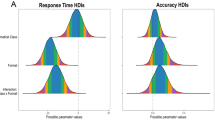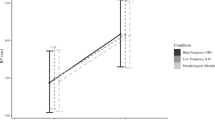Abstract
The differential processing of nouns and verbs has been attributed to a combination of morphological, syntactic and semantic factors which are often intertwined with other general lexical properties. This study tested the noun–verb difference with Chinese disyllabic words controlled on various lexical parameters. As Chinese words are free from inflectional morphology, any psychological distinction observed for nouns and verbs could be more convincingly attributed to syntactic factors echoing their linguistic distinction. Comparison among nouns, verbs and adjectives in lexical decision showed that nouns were processed faster than both verbs and adjectives, while the latter two classes, which are syntactically similar in Chinese, did not show any significant difference. The noun advantage over verbs was consistently found even when the classical frequency effect was duly considered. Thus the noun–verb distinction apparently surfaces at an early stage of lexical processing, and it is suggested that nouns may have a higher base activation level as they are linguistically less complex, which makes their access relatively more facilitated than verbs.
Similar content being viewed by others
Notes
In view of the universality of word classes, Kemmerer and Eggleston (2010) suggested that the correspondence between their linguistic and neurobiological architecture should be more finely discussed with reference to linguistic typology.
The slashes indicate word boundaries.
The Chinese stimuli are listed with their phonetic transcription in Jyutping, a transcription system developed by the Linguistic Society of Hong Kong for Cantonese pronunciations, and an English gloss.
The lists issued by the Hong Kong government recommend the Chinese vocabulary items to be learned by primary school students, during Stage 1 (primary 1 to primary 3) and Stage 2 (primary 4 to primary 6). For the current investigation, we approximate the age of acquisition by means of 1 and 2 respectively according to the lists, and items not found were labelled 3, assuming they are learned at an even later age.
References
Abel, A. D., Maguire, M. J., Naqvi, F. M., & Kim, A. Y. (2014). Lexical retrieval of nouns and verbs in a sentence completion task. Journal of Psycholinguistic Research. doi:10.1007/s10936-014-9304-8.
Balota, D. A., & Chumbley, J. I. (1984). Are lexical decisions a good measure of lexical access? The role of word frequency in the neglected decision stage. Journal of Experimental Psychology: Human Perception and Performance, 10(3), 340–357.
Bleasdale, F. A. (1987). Concreteness dependent associative priming: Separate lexical organization for concrete and abstract words. Journal of Experimental Psychology: Learning, Memory, and Cognition, 13(4), 582–594.
Brown, T. L., Carr, T. H., & Chaderjian, M. (1987). Orthography, familiarity, and meaningfulness reconsidered: Attentional strategies may affect the lexical sensitivity of visual code formation. Journal of Experimental Psychology: Human Perception and Performance, 13(1), 127–139.
Carnie, A. (2002). Syntax: A generative introduction. Malden, MA: Blackwell.
Chao, Y. R. (2002). A grammar of spoken Chinese. Translated by Pang-hsin Ting. Hong Kong: The Chinese University Press.
Chiarello, C., Liu, S., Shears, C., & Kacinik, N. (2002). Differential asymmetries for recognizing nouns and verbs: Where are they? Neuropsychology, 16(1), 35–48.
Chumbley, J. I., & Balota, D. A. (1984). A word’s meaning affects the decision in lexical decision. Memory & Cognition, 12(6), 590–606.
Colombo, L., & Burani, C. (2002). The influence of age of acquisition, root frequency, and context availability in processing nouns and verbs. Brain and Language, 81, 398–411.
Cordier, F., Croizet, J.-C., & Rigalleau, F. (2013). Comparing nouns and verbs in a lexical task. Journal of Psycholinguistic Research, 42(1), 21–35.
Daniele, A., Giustolisi, L., Silveri, M., Colosimo, C., & Gainotti, G. (1994). Evidence for a possible neuro-anatomical basis for lexical processing of nouns and verbs. Neuropsychologia, 32(11), 1325–1341.
Davidoff, J., & Masterson, J. (1995). The development of picture naming: Differences between verbs and nouns. Journal of Neurolinguistics, 9(2), 69–83.
Deutsch, A., Frost, R., & Forster, K. I. (1998). Verbs and nouns are organized and accessed differently in the mental lexicon: Evidence from Hebrew. Journal of Experimental Psychology: Learning, Memory, and Cognition, 24(5), 1238–1255.
Gennari, S., & Poeppel, D. (2003). Processing correlates of lexical semantic complexity. Cognition, 89(1), B27–B41.
Grainger, J. (1990). Word frequency and neighborhood frequency effects in lexical decision and naming. Journal of Memory and Language, 29(2), 228–244.
Hino, Y., & Lupker, S. J. (1996). Effects of polysemy in lexical decision and naming: An alternative to lexical access accounts. Journal of Experimental Psychology: Human Perception and Performance, 22(6), 1331–1356.
HKSAR Education Bureau. (2007). Lexical lists for Chinese learning in Hong Kong. http://www.edbchinese.hk/lexlist/.
Hoosain, R. (1992). Psychological reality of the word in Chinese. In H.-C. Chen & O. J. L. Tzeng (Eds.), Language processing in Chinese (pp. 111–130). Amsterdam: Elsevier.
Kauschke, C., & Stenneken, P. (2008). Differences in noun and verb processing in lexical decision cannot be attributed to word form and morphological complexity alone. Journal of Psycholinguistic Research, 37(6), 443–452.
Kauschke, C., & von Frankenberg, J. (2008). The differential influence of lexical parameters on naming latencies in German. A study on noun and verb picture naming. Journal of Psycholinguistic Research, 37(4), 243–257.
Kemmerer, D., & Eggleston, A. (2010). Nouns and verbs in the brain: Implications of linguistic typology for cognitive neuroscience. Lingua, 120(12), 2686–2690.
Klein, D. E., & Murphy, G. L. (2001). The representation of polysemous words. Journal of Memory and Language, 45(2), 259–282.
Kostić, A., & Katz, L. (1987). Processing differences between nouns, adjectives and verbs. Psychological Research, 49(4), 229–236.
Kroll, J. F., & Merves, J. S. (1986). Lexical access for concrete and abstract words. Journal of Experimental Psychology: Learning, Memory, and Cognition, 12(1), 92–107.
Kwong, O. Y., & Tsou, B. K. (2004). A synchronous corpus-based study of verb–noun fluidity in Chinese. Journal of Chinese Language and Computing, 13(3), 227–238.
Lamb, S. M., & Zhang, X. (2010). The mental representation of Chinese compounds: Evidence from aphasia. Journal of Chinese Linguistics, 38(1), 26–44.
Laudanna, A., Voghera, M., & Gazzellini, S. (2002). Lexical representations of written nouns and verbs in Italian. Brain and Language, 81(1–3), 250–263.
Li, P., Jin, Z., & Tan, L. H. (2004). Neural representations of nouns and verbs in Chinese: An fMRI study. NeuroImage, 21(4), 1533–1541.
Liu, Y., Hua, S., & Weekes, B. S. (2007). Differences in neural processing between nouns and verbs in Chinese: Evidence from EEG. Brain and Language, 103(1–2), 75–77.
Lloyd-Jones, T., & Humphreys, G. W. (1997). Perceptual differentiation as a source of category effects in object processing: Evidence from naming and object decision. Memory & Cognition, 25(1), 18–35.
Martin, A., Haxby, J. V., Lalonde, F. M., Wiggs, C. L., & Ungerleider, L. G. (1995). Discrete cortical regions associated with knowledge with color and knowledge of action. Science, 270(5233), 102–105.
Meltzer-Asscher, A., & Thompson, C. K. (2014). The forgotten grammatical category: Adjective use in agrammatic aphasia. Journal of Neurolinguistics, 30, 48–68.
Morrison, C. M., & Ellis, A. W. (1995). Roles of word frequency and age of acquisition in word naming and lexical decision. Journal of Experimental Psychology: Learning, Memory, and Cognition, 21(1), 116–133.
Rösler, F., Streb, J., & Haan, H. (2001). Event-related brain potentials evoked by verbs and nouns in a primed lexical decision task. Psychophysiology, 38(4), 694–703.
Schwanenflugel, P. J. (1991). Why are abstract concepts hard to understand? In P. J. Schwanenflugel (Ed.), The psychology of word meanings. Hillsdale, NJ: Lawrence Erlbaum.
Sereno, J. A. (1999). Hemispheric differences in grammatical class. Brain and Language, 70(1), 13–28.
Shapiro, K., & Caramazza, A. (2003). The representation of grammatical categories in the brain. Trends in Cognitive Sciences, 7(5), 201–206.
Spruyt, A., Clarysse, J., Vansteenwegen, D., Baeyens, F., & Hermans, D. (2010). Affect 4.0: A free software package for implementing psychological and psychophysiological experiments. Experimental Psychology, 57(1), 36–45.
Szekely, A., D’Amico, S., Devescovi, A., Federmeier, K., Herron, D., Iyer, G., et al. (2005). Timed action and object naming. Cortex, 41(1), 7–26.
Tsai, J.-L., Lee, C.-Y., Lin, Y.-C., Tzeng, O. J. L., & Hung, D. L. (2006). Neighborhood size effects of Chinese words in lexical decision and reading. Language and Linguistics, 7(3), 659–675.
Vigliocco, G., Vinson, D. P., Fruks, J., Barber, H., & Cappa, S. F. (2011). Nouns and verbs in the brain: A review of behavioral, electrophysiological, neuropsychological and imaging studies. Neuroscience and Biobehavioral Reviews, 35(3), 407–426.
Yu, X., Law, S. P., Han, Z., Zhu, C., & Bi, Y. (2011). Dissociative neural correlates of semantic processing of nouns and verbs in Chinese—A language with minimal inflectional morphology. NeuroImage, 58(3), 912–922.
Zhang, Q., Ding, J., Guo, C., & Wang, Z. (2003). ERP difference between processing of nouns and verbs. Acta Psychologica Sinica, 35(6), 753–760.
Acknowledgments
The experiments reported in this paper were done when the author was affiliated to the City University of Hong Kong, with grant support gratefully received from CityU (Project No. 7002798).
Author information
Authors and Affiliations
Corresponding author
Rights and permissions
About this article
Cite this article
Kwong, O.Y. There is Something About Grammatical Category in Chinese Visual Word Recognition. J Psycholinguist Res 45, 1067–1087 (2016). https://doi.org/10.1007/s10936-015-9392-0
Published:
Issue Date:
DOI: https://doi.org/10.1007/s10936-015-9392-0




